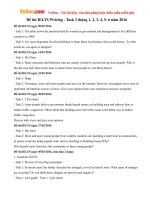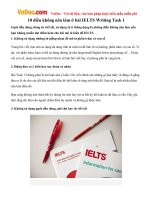IELTS ACADEMIC WRITING PART 1
Bạn đang xem bản rút gọn của tài liệu. Xem và tải ngay bản đầy đủ của tài liệu tại đây (4.46 MB, 142 trang )
IELTS
ACADEMIC
WRITING
PART 1
DR. MICHAEL R. DAVIS
1
Dr. Michael R. Davis, Writing part 1, Version 2 .0 December 9, 2016
Table of Contents
Section 1: Overview
Introduction and Rubric
Task Types
Assessment Criteria
Band Descriptors
Academic Vocabulary
Writing Format
Section 2: Line Graphs
Describing Trends
Grammar for Describing Trends
Linking
Approaches to Reporting Figures
Section 3: Bar Charts
Comparison Language
Section 4: Pie Charts
Reporting Proportions
Section 5: Tables
Section 6: Multiple Graphs
Section 7: Process Papers
Section 8: Maps
3.
4.
6.
11.
13.
15.
16.
22.
23.
25.
28.
29.
40.
53.
59.
60.
70.
83.
96.
115.
2
Dr. Michael R. Davis, Writing part 1, Version 2 .0 December 9, 2016
Section 1
Overview and Tutorials
3
Dr. Michael R. Davis, Writing part 1, Version 2 .0 December 9, 2016
Introduction
Understanding the Rubric
General comments: This is a general rubric, there will be slight
variations with different types of questions
150 minimum – 175 maximum. Remember under and over the limit can incur
a penalty.
Don’t waste words with flowery and passive writing.
Use power words and adjectives consistently.
Introduction: 1 sentence
A. Paraphrase (DO NOT COPY) what you see.
Paragraph 2: 2 Sentences
What are the two main trends/patterns (in a process essay divide the
process into two broad stages).
You can start it by writing. “The first __________ trend is….. The second
__________ is….. until you find your own style. The blank is for you to supply
an appropriate adjective, i.e. The first significant trend is…..
Paragraph 3: 3-4 sentences
Describe in detail trend/stage 1
Paragraph 3: 3-4 sentences
Describe in detail trend/stage 2
THERE IS NO CONCLUSION IN PART 1 WRITING
4
Dr. Michael R. Davis, Writing part 1, Version 2 .0 December 9, 2016
The Task
Task 1 involves reporting the data in a visual item or collection of data such as a
table. You have to:
• Summarise the information in the visual or set of data:
▪ Select the main features
▪ Report the main features
• Make comparisons were relevant
• write at least 150 words to 175 words
The Answer Sheet
The last two pages of the IELTS writing answer sheet are dedicated to task two and
together have over 40 lines. Although you may ask for extra sheets to write your
answer in, this is not likely to become necessary since the space you are already
provided with is way more than sufficient. You must not write in the blank space at
the bottom of the first page or in the scoring section at the bottom of page two.
5
Dr. Michael R. Davis, Writing part 1, Version 2 .0 December 9, 2016
Task Types
You may be given a single visual or a combination of 2 or 3 different task types.
Trend tasks
6
Dr. Michael R. Davis, Writing part 1, Version 2 .0 December 9, 2016
Comparison tasks
7
Dr. Michael R. Davis, Writing part 1, Version 2 .0 December 9, 2016
Process and Cycle Diagrams
8
Dr. Michael R. Davis, Writing part 1, Version 2 .0 December 9, 2016
Map Tasks
Comparison Maps
9
Dr. Michael R. Davis, Writing part 1, Version 2 .0 December 9, 2016
Mixed Tasks
10
Dr. Michael R. Davis, Writing part 1, Version 2 .0 December 9, 2016
Assessment Criteria
Every report is read four times by an examiner and each time, it will be marked on
one of the following criteria:
Task Achievement (TA)
Coherence and Cohesion (CC)
Lexical Resource (LR)
Grammatical Range and Accuracy (GRA)
Task Achievement (TA)
This criterion assesses how appropriately, accurately and relevantly the response
fulfils the requirements set out in the task, using the minimum of 150 words.
Academic Writing Task 1 is a writing task which has a defined input and a largely
predictable output. It is basically an information-transfer task which relates narrowly
to the factual content of the input data or diagram and NOT to speculated
explanations that lie outside the provided diagram or data.
The examiner has the following questions in mind when assessing this aspect of your
report:
1. Have you summarised the information appropriately by selecting and properly
reporting the main features?
2. Have you made comparisons properly and sufficiently?
3. Have you provided overviews of the main trends/comparisons/stages?
4. Have you written a clear overview or summary for the report?
Coherence and Cohesion (CC)
This criterion is concerned with the overall clarity and fluency of the message: how
the response organises and links information, ideas and language. Coherence refers
to the linking of ideas through logical sequencing. Cohesion refers to the varied and
appropriate use of cohesive devices (for example, logical connectors, pronouns
and conjunctions) to assist in making the conceptual and referential relationships
between and within sentences clear. The examiner has the following questions in
mind when assessing this aspect of your report:
5. Have you organised your information logically?
6. Is there an overall flow or progression in your report?
11
Dr. Michael R. Davis, Writing part 1, Version 2 .0 December 9, 2016
7. Have you used linkers correctly, properly and sufficiently?
8. Have pronouns been used correctly and do they have clear references?
9. Have you organised the text in paragraphs logically and sufficiently?
Lexical Resource (LR)
This criterion refers to the range of vocabulary the candidate has used and the
accuracy and appropriacy of that use in terms of the specific task.
The examiner takes the following points into account when assessing this aspect of
your report:
1. Words
a. Range and flexibility
b. Level
c. Precision
d. Style
e. Collocation
2. Vocabulary mistakes
a. Spelling
b. Word choice
c. Word formation
Note: when evaluating mistakes, the effect each has on the reader and the
intelligibility of your report is taken into account.
Grammatical Range and Accuracy (GRA)
This criterion refers to the range and accurate use of the candidate’s grammatical
resource as manifested in the candidate’s writing at the sentence level.
The examiner has the following questions in mind when assessing this aspect of your
report:
1. Have you used a variety of sentence structures?
2. How often have you used compound structures?
3. Mistakes
a. Grammar
b. Punctuation
Note: when evaluating mistakes, the effect each has on the reader and the
intelligibility of your report is taken into account.
12
Dr. Michael R. Davis, Writing part 1, Version 2 .0 December 9, 2016
IELTS Task 1 Writing Band Descriptors (Public Version)
13
Dr. Michael R. Davis, Writing part 1, Version 2 .0 December 9, 2016
14
Dr. Michael R. Davis, Writing part 1, Version 2 .0 December 9, 2016
General note on academic caution
vocabulary
The language of academic caution can be used in IELTS to improve
the coherence of your writing and speaking. Here are some basic
variations
Grammatical problems
Please note this common mistake made with some/many/few/most
Variations - word families
To use these words well, you need to be able to use the different forms
of the words. Here are just two examples
Possible
15
Dr. Michael R. Davis, Writing part 1, Version 2 .0 December 9, 2016
Probable
Variations - qualifying adverbs
If you want to add further variation to your speaking/writing, consider
using adverbs of degree such as “fairly”, “quite” and “rather”; eg
It is fairly likely that
It is quite probable that
It is rather unlikely that
Variations - some idiomatic expressions for general ideas
Here are some more idiomatic expressions to express general ideas. As
ever, choose the expressions that mean something to you and practice
using them in context.
16
Dr. Michael R. Davis, Writing part 1, Version 2 .0 December 9, 2016
17
Dr. Michael R. Davis, Writing part 1, Version 2 .0 December 9, 2016
Writing Format
Common Problems
1. Not knowing which information to include in your answer.
2. Being unaware of what the examiner expects.
3. Including opinion and drawing conclusions.
4. Not using an appropriate structure.
5. Not using appropriate grammar for describing data, trends and making
comparisons.
6. Not using a wide variety of appropriate vocabulary.
7. Failing to write an effective overview.
8. Copying words and phrases from the question.
9. Failing to support descriptions, trends and comparisons with accurate
data.
10. Writing one long paragraph.
These common problems will stop you getting the IELTS band score you
deserve. The advice below will help you prevent these problems and achieve
the score you want.
Different Kinds of Chart Question
All of these charts do one principal thing- represent numbers. Your task is to
describe these numbers.
There are four different types of chart you may have to describe. They are:
1. Line Chart (sometimes called a line graph)
2. Bar Chart
3. Pie Chart
4. Proportional Bar Chart
You also need to ask yourself if it is a static or dynamic chart. A static chart
shows data from one time period. A dynamic chart shows change over time.
These will obviously require different tenses.
Structure
The structure I advise all my students to write is a very simple four paragraph
structure. You can use a different structure if you like, but this one has been
proven to be successful and approved by IELTS examiners.
Paragraph 1 (Introduction)
Sentence 1- Paraphrase Question
This paragraph should be one sentence long and demonstrates your ability
to paraphrase. You do this by using synonyms and we will look at it in more
detail below.
Paragraph 2 (Overview)
18
Dr. Michael R. Davis, Writing part 1, Version 2 .0 December 9, 2016
Sentence 1- Overview of first main feature
Sentence 2- Overview of second main feature
Sentence 3- Make general comparison, if appropriate
An overview is a general statement, highlighting the most important
information in the table. It should not include any numbers. This is just a
summary of the main features. You can use numbers to support your answer
in paragraphs 3 and 4.
The examiner is testing your ability to identify the most important information
and then summarise it. Important information could include general trends,
increase/decreases, differences, comparisons etc.
More on how to identify significant features and write an effective overview
below.
Paragraph 3 (Details of significant feature 1)
Sentence 1- Supporting details
Sentence 2- Supporting details
Sentence 3- Supporting details/comparison details/exceptions, if appropriate
In this paragraph you take the first general statement from paragraph 2 and
support it with details from the graph. The examiner is looking for your ability
to choose the correct data and ability to describe data, trends, comparisons
etc..
You then repeat this process for paragraph 4, only this time you describe the
second sentence in paragraph 2.
Paragraph 4 (Details of significant feature 2)
Sentence 1- Supporting details
Sentence 2- Supporting details
Sentence 3- Supporting details/comparison details/exceptions, if appropriate
That’s it. Four paragraphs and 9-10 sentences. Obviously, you need to be
flexible and write 8-12 sentences depending on the question. There may also
be three significant features, in which case you can adjust the structure
slightly.
You should not write a conclusion. Conclusions are for opinion or discursive
essays and we are not expected to this in task 1.
This structure will allow you to practice this kind of question over and over,
giving you confidence and a consistent model in the exam.
Identifying Main Features
19
Dr. Michael R. Davis, Writing part 1, Version 2 .0 December 9, 2016
This is often the area most students struggle with and it is because of one
main reason. Students need to priorities. Prioritizing means you should choose
two or three significant features and just write about these. The examiner
expects you to do this and the question will often specifically say ‘select main
features.’ There should be 2 or 3 main features for you to comment on.
When students don’t do this they write about every single piece of data they
see. This results in them not summarizing (this is a summarizing task), not writing
an effective overview and spending too much time on this task. How many
students do you know who spent too much time on task 1 and didn’t finish
task 2?
Things that you should be looking for include:
High/low values
Erratic values
Biggest increase/decrease
Volatile data
Unchanging data
Biggest majority/ minority (pie charts)
Biggest difference/similarities
Major trends
Notable exceptions
Looking for these things should allow you to pick out the most important
features.
Another thing students often do is overthink the question. They think that the
answer is too obvious and therefore don’t write about it. A common main
feature is a general increase or decrease. Some students see this as too
simple and ignore it all together. Don’t do this, reporting obvious or simple
features is fine.
20
Dr. Michael R. Davis, Writing part 1, Version 2 .0 December 9, 2016
Sample Answer
The diagram shows the levels of charitable donations of people living in
Britain, separated by age, between 1990 and 2010.
Overall, there was a general decrease in the percentage of people who
donated money over the two time periods. However, the pattern differs
between the three age groups before 50 and the two age groups after the
age of 50.
The highest decrease was in the 18-25 category, which saw a decrease of
10%, from 17% in 1990 to 7% in 2010. 42% of people in the 36-50 age group
gave to charity in 1990, the highest on the chart, and this fell to 35% in 2010.
There was also a significant decline in donations among 26-35 year olds, from
31% to 24%.
The exception to this general trend downwards was among the 51-65 year
olds and over 65s. In 2010, the 51-65 year olds gave the highest percentage
with nearly 40 per cent and this rose from 35% in 1990. Finally, those over 65
displayed a slight percentage increase of 3 per cent.
(174 words)
As you can see, this answer follows my structure I suggested above.
21
Dr. Michael R. Davis, Writing part 1, Version 2 .0 December 9, 2016
Step by Step Instructions
I will now take you through my thought processes and show you step by step
how to answer a question like this.
1. Read the question twice very carefully.
2. Look at the data. What data is represented on the axis? What groups
are represented? What time periods are shown? What are units of
measurements?
3. What are the main features?
4. Can I make any comparisons? Are there any exceptions?
5. Make a quick plan using above structure.
6. Write introduction by paraphrasing question.
7. Write second paragraph, which is summary or overview of main
features.
8. Support the ideas in second paragraph with more detail in third and
fourth paragraphs.
9. I’ve got at least 150 words.
After writing, I should be able to hand this to a stranger and they would be
able to draw the graph.
22
Dr. Michael R. Davis, Writing part 1, Version 2 .0 December 9, 2016
Section 2
Line Graphs
This section generally addresses trend diagrams.
Some aspects concerning comparisons and
proportions will be addressed in sections 2 and 3.
23
Dr. Michael R. Davis, Writing part 1, Version 2 .0 December 9, 2016
Vocabulary for Describing Trends
A) Verbs and nouns for describing trends and changes:
24
Dr. Michael R. Davis, Writing part 1, Version 2 .0 December 9, 2016
B) Adjectives and adverbs for degree of change:
C) Adjectives and adverbs for speed of change:
25
Dr. Michael R. Davis, Writing part 1, Version 2 .0 December 9, 2016









